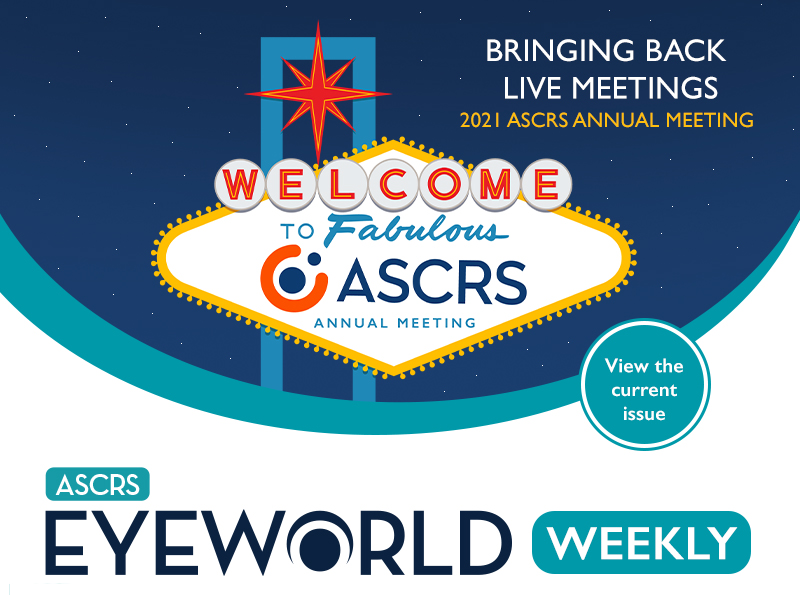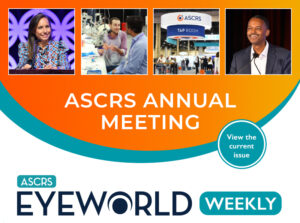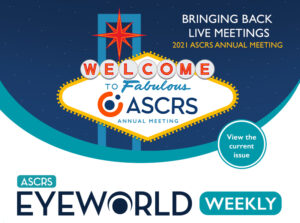
- Phase 2 clinical trial of minocycline for MGD
- Phase 2a study of drug-eluting contact lens for glaucoma
- Phase 1/2 results of RNA therapy for Usher syndrome, non-syndromic retinitis pigmentosa
- First regulatory approval for a therapeutic contact lens that treats ocular allergies
- Moist heat masks effective for signs, symptoms of dry eye, study finds
- ASCRS Journal Club on April 8
March 26, 2021 • Volume 27, Number 12
Phase 2 clinical trial of minocycline for MGD
Hovione completed its Phase 2 clinical trial of preservative-free minocycline (Meizuvo) in patients who have dry eye related to MGD. The multicentered study included 270 patients randomized into one of three groups, receiving a certain dose of minocycline or vehicle. According to the company’s press release, 70% of patients, who at baseline had inflammatory biomarkers, had positive clinical outcomes. The research saw a 25-point improvement in discomfort on the visual analogue scale 2 weeks after treatment, continuing to drop to 35 points by the end of the treatment period, equating to a more than 50% improvement. Both groups receiving minocycline vs. vehicle had statistically significant improvement in corneal staining. Adverse effects included blurred vision and ocular irritation, occurring in less than 3% of participants. According to the company, minocycline is designed to target the inflammatory component of MGD via a synergistic mechanism of downregulation of the inflammatory process.
Phase 2a study of drug-eluting contact lens for glaucoma
MediPrint Ophthalmics announced results from its Phase 2a study of LLT-BMT1, a drug-eluting contact lens for treatment of glaucoma and ocular hypertension. Five patients received this contact lens, which the company stated has bimatoprost “printed” on it via a proprietary process; the average participant age was 77.4 years, and they hadn’t worn contact lenses prior. The contact lenses were used in both eyes for 7 days continuously. According to the company’s press release, safety, tolerability, and efficacy were demonstrated in the small group. The company specifically noted a lower incidence of hyperemia with the bimatoprost-eluting contact lens compared to bimatoprost drops. The company stated it will move forward with a larger Phase 2b dose-ranging study.
Phase 1/2 results of RNA therapy for Usher syndrome, non-syndromic retinitis pigmentosa
ProQR Therapeutics announced results from its Phase 1/2 trial of QR-421a as a treatment for adults with Usher syndrome and non-syndromic retinitis pigmentosa due to USH2A exon 13 mutations. According to the company’s press release, the study included 20 patients, 14 of whom received the experimental treatment, six of whom received a sham. The investigators found that a single dose of this RNA therapy was safe and well tolerated. In all treated patients, a mean benefit of six letters on the Early Treatment of Diabetic Retinopathy Study letter chart was observed. A mean benefit of 9.3 letters at week 48 was observed in advanced patients (no patients in the sham group saw a benefit in the treatment eye), according to the company’s press release. Mean total retinal sensitivity improvement was higher in treated eyes compared to untreated eyes. The company’s press release said all primary objectives were met in the study, setting registration endpoints, dose, dosing interval, and patient population for future Phase 2/3 pivotal trials.
First regulatory approval for a therapeutic contact lens that treats ocular allergies
The Japanese Ministry of Health, Labour and Welfare approved Johnson & Johnson Vision’s ACUVUE Theravision with Ketotifen contact lens, indicated for vision correction and itch relief due to allergies. This is the first regulatory approval for a contact lens combining vision correction and the antihistamine for patients who experience allergic conjunctivitis, according to Johnson & Johnson Vision.
Moist heat masks effective for signs, symptoms of dry eye, study finds
With warm compresses often among the first treatments for signs and symptoms of dry eye disease, Eye Eco sought to validate the efficacy of its moist heat masks. In a randomized, multicentered, observer-masked study, 36 patients with MGD had manual meibomian gland expression followed by home use of the moist heat masks (Tranquilvibes or Tranquileyes XL) for 20 minutes daily. According to the company’s press release, after 30 days, patients had 32% better symptom scores, about a 70% increase in tear breakup time, improved conjunctival and corneal staining, and other improvements in signs.
ASCRS Journal Club on April 8
Plan to join ASCRS’ interactive Journal Club on Thursday, April 8, from 9:00–10:00 P.M. ET for another session in this monthly series in which a panel of experts discusses two pre-selected manuscripts from the Journal of Cataract & Refractive Surgery. Nick Mamalis, MD, and Leela Raju, MD, co-moderate these free CME sessions, open to all ASCRS members. The April session will feature Kerry Solomon, MD, and Sabrina Mukhtar, MD, as discussants, and Warren Hill, MD, Naveen Rao, MD, and Mitch Weikert, MD, as panelists.
Research highlights
- A single-center study sought to compare IOP lowering and safety of pattern scanning laser trabeculoplasty (PSLT) and selective laser trabeculoplasty (SLT) in patients with primary open-angle glaucoma or ocular hypertension over a 12-month period. The study included 132 consecutively enrolled patients who were randomized to receive either PSLT or SLT. IOP was measured at baseline, day 1, week 1, and months 1, 3, 6, 9, and 12. The mean baseline IOP was 21.2±4.1 mm Hg in the PSLT group and 21.3±4.7 mm Hg for SLT. At the 12-month mark, IOP was 18.3±3.1 and 17.8±3.4 mm Hg in the PSLT and SLT groups, respectively. Overall, the investigators found that a higher baseline IOP and a greater percent IOP reduction at day 1 was associated with a greater percent IOP reduction at month 12. No significant differences were observed in visual field mean deviation, retinal nerve fiber layer thickness, endothelial cell counts, or visual acuity. With these findings, the authors concluded that PSLT is not superior to SLT in safety or IOP lowering. This study is published in the British Journal of Ophthalmology.
- A case report published in the journal Cornea described a patient with genetically confirmed granular corneal dystrophy type 2 (GCD2) who had unilateral SMILE. Two months after SMILE, the patient (age 23) presented with two faint opacities at the surgical interface, the authors wrote. GCD2 deposits were identified beneath Bowman’s layer in the patient’s right and left corneas. The authors of the case report observed an increase in the density, size, and number of the deposits in the surgical interface in the right eye. Fourier domain OCT at 33 months postop showed that the deposits at the SMILE interface were distinct from those at Bowman’s layer. They wrote that the disease exacerbation appeared less than what is usually seen in patients who have had LASIK or PRK. The authors wrote that this case underlines the importance of genetic testing before corneal refractive procedures, especially for patients who have corneal opacities preop or if they have a family history of corneal disease.
This issue of EyeWorld Weekly was edited by Stacy Jablonski and Liz Hillman.
EyeWorld Weekly (ISSN 1089-0319), a digital publication of the American Society of Cataract and Refractive Surgery (ASCRS), is published every Friday, distributed by email, and posted live on Friday.
Medical Editors: Eric Donnenfeld, MD, Chief Medical Editor; Rosa Braga-Mele, MD, Cataract Editor; Clara Chan, MD, Cornea Editor; Nathan Radcliffe, MD, Glaucoma Editor; and Vance Thompson, MD, Refractive Editor
For sponsorship opportunities or membership information, contact: ASCRS • 12587 Fair Lakes Circle • Suite 348 • Fairfax, VA 22033 • Phone: 703-591-2220 • Fax: 703-591-0614 • Email: ascrs@ascrs.org
Mention of products or services in EyeWorld Weekly does not constitute an endorsement by ASCRS.
Click here to view our Legal Notice.
Copyright 2021, EyeWorld News Service, a division of ASCRSMedia. All rights reserved.



